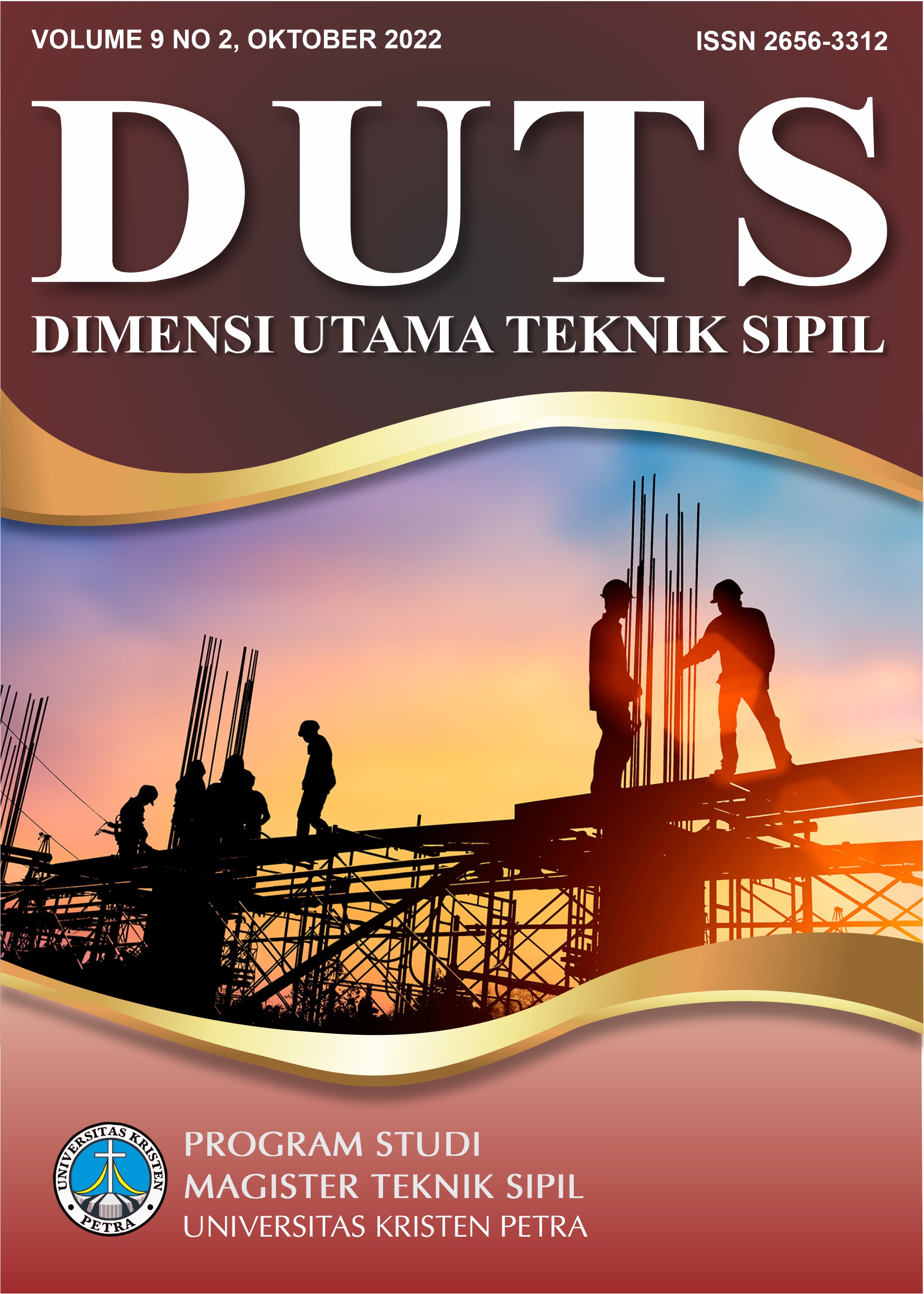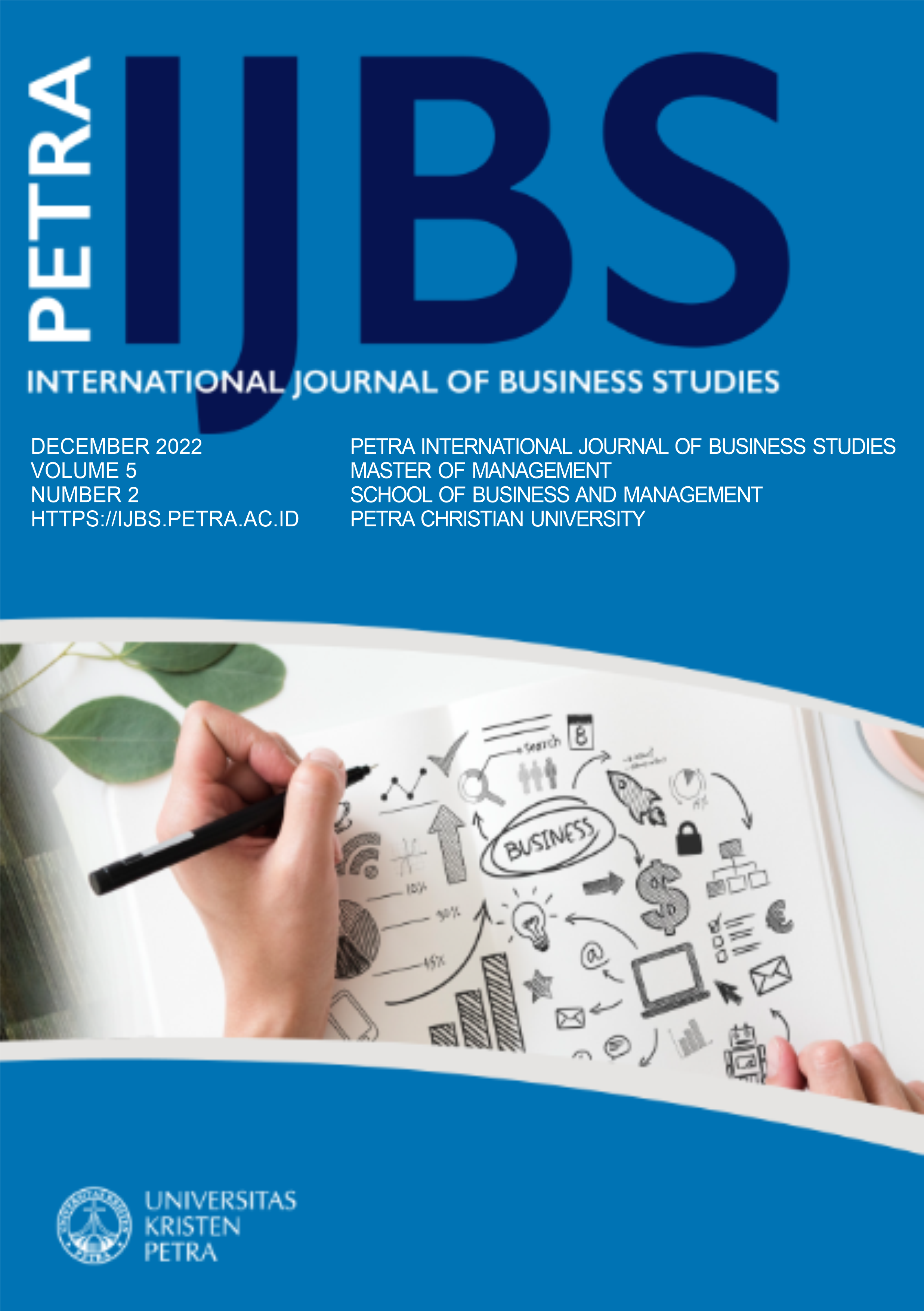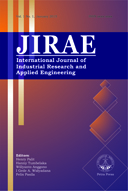Peer-Reviewed e-Journal ini adalah kumpulan jurnal ilmiah tanah air. Bertujuan sebagai media diseminasi artikel ilmiah yang dapat diakses luas oleh publik. Diharapkan menjadi kontribusi positif bagi keilmuan di Indonesia.
Situs ini dimungkinkan karena kerjasama berbagai pihak dengan dukungan program Inherent K-1 DIKTI.
Dimensi Utama Teknik Sipil
Dimensi Utama Teknik Sipil (DUTS) e-ISSN 2656-3312 is a peer-reviewed online journal that is published biannually, in April and October, by Petra Christian University, Surabaya, Indonesia. This journal was first published in October 2014. This journal serves as a forum for academicians and practicing engineers to disseminate their latest research results and findings in the field of civil engineering.
International Journal of Business Studies
Petra International Journal of Business Studies (IJBS), ISSN: 2621-6426, is a peer-reviewed journal published under the Master of Management Program, School of Business and Management, Petra Christian University (MM-SBM UKP). The journal serves as a vessel for exchanging business and management knowledge with scholars and practitioners, which publish their scholarly works twice a year (June and December).
Petra IJBS welcomes submissions of manuscripts, most notably in the field of management, marketing, finance, supply chain management, human resources, and accounting. Publications of articles related to the fields mentioned above of inquiry are made twice a year (June and December). The Publisher requires the transfer of copyright for the first publication only. However, for the avoidance of doubt, where Exceptions and limitations apply to the Authors use, the transfer of copyright does not apply, and the author retains the copyright without any restriction.
International Journal of Financial & Investment Studies
International Journal of Financial and Investment Studies (IJFIS e-ISSN: 2745-3952) is a peer-reviewed journal that aims at the dissemination and advancement of research in the areas of economics and finance with a specific focus on financials and investments. The aim of the Journal is to provide a platform to researchers, practitioners, academicians, and professionals associated with the field of financials and investments. To encourage and promote research across a wide breadth of areas pertaining to financials and investments. Preference will be given to comparative studies that take global and regional perspectives as well as comprehensive single country studies that address critical policy issues and have significant global and regional implications.
The International Journal of Financial and Investment Studies invites submissions of original, empirical, and theoretical papers as well as case studies and book reviews covering diverse areas of financial and investments that are listed (but not limited to) as follows:
• Analysis and design of trading mechanisms;
• Optimal order placement strategies in capital market;
• The role of information in securities markets/investments
• Behaviour of asset prices in financial sectors;
• Capital, security, and derivatives markets; securities and derivatives trading and pricing (stocks, bonds, currencies, commodities);
• Corporate governance;
• Corporate restructuring: Share buybacks, delisting, mergers, and acquisitions;
• Credit markets and leverage buy outs;
• Investment and portfolio management;
• Market efficiency;
• Market mechanisms;
• New issues market and merchant banking;
• Normative theory of financial management;
• Performance and regulations of mutual funds;
• Private placements: preferential issues, qualified institutions placements;
• Real estate investment trusts;
• Securities and Exchange Board of Indonesia: rules and regulations;
• Theories of market equilibrium;
• Valuation of bonds, convertible debentures, and market for debt;
• Valuation of financial and real assets;
• Valuation of stocks and functioning of the stock markets;
• Valuation, trading, hedging, investing, and pricing issues in global stock, bond, commodity, currency, and derivative markets;
• Studies of market theory, regulation, and investment management;
International Journal of Organizational Behavior and Policy
International Journal of Organizational Behavior and Performance (IJOBP) is peer–reviewed journal publishing high–quality, original research and published biannually (January and July) by Universitas Kristen Petra, Indonesia. IJOBP provides a platform for dissemination and publication of your work and dedicated to advancing the understanding of sustainability and sustainable development. IJOBP aspires to harmonize theory and practice in the areas of business, accounting, economics, taxation, management and social. IJOBP emphasizes the linkages between organizational behaviour, social and economic issues in corporations, governments, education institutions, regions, societies and performance. IJOBP welcomes papers covering global, national, regional, or even local focus from a philosophical to a practical perspective. It comprises of theoretical and empirical research and for innovative concepts providing a blend of theory and practices of organizational behaviour globally to cater to the interests of practitioners, academics, researchers, students and policy makers. Papers accepted for publication are double–blind review to ensure academic rigor and integrity. Authors will be asked to provide a novelty and relevance statement indicating how the results are deemed to be original with respect to the state–of–the–art in the field, relevant and essential to the advance of knowledge on sustainability and applicable to a wider audience and wider contexts.
Please follow the journal's Aims and Scope for information about its focus and peer–review policy. Topic areas include, but are not limited to traditional perspectives on theory and on the study of behavior in organization, such as, for example, decision making, goal setting, justice, leadership, learning, motivation, performance, personality, intellectual capital, organizational capital, corporate governance, corporate sustainability, sustainability audit, sustainable tax, tax morale and ethics, behavioural economics, sustainable education, sustainable finance, accountability and reporting.
International Journal of Industrial Research and Applied Engineering
JIRAE is a peer-reviewed international journal providing a medium for the academic and industrial community to share cutting-edge research and development in various aspects of industrial technology and applied engineering. The three-pronged objectives are:
- To encourage research work in the field of industrial technology and applied engineering among scientists, researchers, engineering practitioners, and industrial experts to improve efficiency, reduce costs, and generate high-quality products / services;
- To promote the adoption and development of comprehensive and state-of-the-art technologies for enterprises and industries;
- To bridge the theoretical and practical gap between academia and industry, and advocate collaboration to address enterprise and industry challenges.
JIRAE welcomes papers with the above aims and scopes. The editorial board decides papers to be published in JIRAE after review by reviewers appointed by the board. Authors will be advised of reviewers' comments and suggestions. Papers previously presented in a conference not specifically associated with Petra Christian University Publication will be considered.
Journals
-
Civil Engineering Dimension
Civil Engineering Dimension (p-ISSN: 1410-9530 and e-ISSN: 1979-570X) is a peer-reviewed journal published by The Institute of Research and Community Outreach at Petra Christian University, Surabaya, Indonesia (www.petra.ac.id). Released biannually, it offers issues in March and September.
Civil Engineering Dimension (CED) proudly holds the prestigious highest accreditation status (SINTA-1) awarded by the Directorate General of Higher Education (DGHE), Indonesia, under decree number 225/E/KPT/2022, dated December 7, 2022. This accreditation remains valid for five years, spanning from volume 24, number 1, 2022, through volume 28, number 2, 2026. Moreover, CED is indexed in multiple international databases and has earned the esteemed green tick status from DOAJ (http://www.doaj.org).
-
Jurnal Teknik Industri: Jurnal Keilmuan dan Aplikasi Teknik Industri
The Jurnal Teknik Industri: Jurnal Keilmuan dan Aplikasi Teknik Industri (Journal of Industrial Engineering: Research and Application) (p-ISSN 1411-2485 | e-ISSN 2087-7439) is a prestigious biannual publication by Petra Christian University, showcasing the latest in industrial engineering research and applications. Accredited by the Ministry of Education, Culture, Research, and Technology of Indonesia since 2003, it serves as a platform for promoting interdisciplinary approaches in industrial engineering, facilitating academic exchanges, and encouraging research among scientists, engineers, and professionals. Published every June and December, the journal invites contributions that align with its aims. The editorial process involves rigorous review by appointed experts, ensuring high-quality publications. The journal supports open access, free for readers online, and does not impose article submission fees. However, an article publication fee applies for authors affiliated with Indonesian institutions, while international authors enjoy free publication. Submission guidelines emphasize a comprehensive manuscript organization, adherence to SI units, clarity in figures and tables, and meticulous mathematical presentation. Journal of Industrial Engineering: Research and Application upholds the highest standards against plagiarism, offering copyright flexibility under the Creative Commons Attribution License, ensuring the broad dissemination and impact of published work.
The Jurnal Teknik Industri accredited by the Ministry of Education, Culture, Research, and Technology of the Republic of Indonesia since 2003, with its decree: No. 35/DIKTI/Kep/2003; No. 45/DIKTI/Kep/2006; No. 83/DIKTI/Kep/2009; No. 56/DIKTl/Kep/2012; No. 32a/E/KPT/2017; No. 105/E/KPT/2022.
-
Jurnal Akuntansi dan Keuangan
The Jurnal Akuntansi dan Keuangan (JAK) (p-ISSN 1411-0288 | e-ISSN 2338-8137) is a peer-reviewed journal, published biannually in May and November by The Institute of Research and Community Outreach, Petra Christian University, Surabaya, Indonesia.
The JAK invites manuscripts in the various topics include, but not limited to, functional areas of accounting and finance, financial accounting and securities market, management accounting, accounting information systems, auditing and taxation.
The Jurnal Akuntansi dan Keuangan is accredited by the Ministry of Education and Culture of the Republic of Indonesia, No. 158/E/KPT/2021, valid for 5 (five) years.
-
Dimensi: Journal of Architecture and Built Environment
Journal of DIMENSI (p-ISSN 0126-219X, e-ISSN 2338-7858) is a peer-reviewed journal devoted to the applications of architecture theory, sustainable built environment, architectural history, urban design and planning, as well as building structure. We accept National and International original research articles which are free of charged at this moment. The manuscript will be reviewed by two independent National or International advisory boards who are in their expert field.
DIMENSI is published, twice a year, in July and December, by the Institute for Research and Community Services, Petra Christian University, Surabaya-Indonesia. DIMENSI will be distributed to other universities, research centers, and National or International advisory board as well as to regular subscribers.
The latest accreditation decree is No. 148/M/KPT/2020, dated 2 Agustus 2020, valid for 5 (five) years.
-
Jurnal Manajemen dan Kewirausahaan
Jurnal Manajemen dan Kewirausahaan (JMK) or Journal of Management and Entrepreneurship is published biannually, in March and September, by Petra Christian University. JMK aims to:
1. Promote recent research results on Management and or Entrepreneurship.
2. Publish only research results on Management (such as Marketing Management, Financial Management, Employee Management, Operation/Production Management, Business Management, etc.) and or Entrepreneurship as a knowledge development.
JMK welcomes papers with the above aims and scopes. The editorial board decides papers to be published in JMK after reviewed by appointed reviewers (double blind review). Authors will be advised of reviewers' comments and suggestions.
JMK or Journal of Management and Entrepreneurship (p-ISSN: 1411-1438 and e-ISSN: 2338-8234) is an Open Access Journal, which is free to access and read on the Internet.
NO FAST TRACK
-
Share: Journal of Service Learning
The SHARE journal was born as a medium of information, interaction and reflection for academicians which is projected as a vehicle to share scientific insights, services provided and learning experienced to the community. The SHARE journal is expected to be a "never-ending fire" that continues to encourage academicians in community service and service-learning activities in the community. Philosophically, journal "identity" can be interpreted as follows: 1. "SHARE" is an acronym for SHaring - Action - REflection which means "sharing, action and reflection". This means a continuous process. 2. The word "SHARE" itself means sharing. The SHARE journal focuses on material community service activities carried out by lecturers, practitioners and students, including articles on the results of community service outcomes from the Ministry of Research and Technology grant. And this journal is not called a communication medium because the word series "sharing-action-reflection" is much more meaningful than the definition of "communication". The SHARE: Journal of Service-Learning (p-ISSN: 2338-7866 | e-ISSN: 2655-4720) is published twice a year, in February and August by Institute of Research and Community Outreach Petra Christian University, Indonesia.
-
Jurnal Teknik Elektro
Jurnal Teknik Elektro (p-ISSN 1411-870X and e-ISSN 2656-3304) is published biannually, in March and September, by Petra Christian University.
Jurnal Teknik Elektro aims to:
1. Promote a comprehensive approach to electrical engineering incorporating viewpoints of different disciplines.
2. Strengthen academic exchange with other institutions.
3. Encourage scientist, practicing engineers, and others to conduct research and other similar activities. -
Jurnal Informatika
Jurnal Informatika (p-ISSN 1411-0105 and e-ISSN 2528-5823) is published biannually, in May and November, by Petra Christian University.
Jurnal Informatika aims to:
1. Promote a comprehensive approach to informatics engineering and management incorporating viewpoints of different applications (computer graphics, comp. networks, comp. vision, operating systems, Internet/Intranet developments, computational intelligent, databases, IT project management, etc.).
2. Strengthen academic exchange with other institutions in the area of informatics engineering and management.
3. Encourage scientist, practicing engineers, and others to conduct research and other similar activities. -
Jurnal Teknik Mesin
Mechanical Engineering Journal (JTM) is a peer-reviewed journal for Scientific and Applied Mechanical Engineering. Publisher by Department Mechanical Engineering, Petra Christian University.
JTM was first published in April 1999. JTM has received National Journal accreditation from the Director General of Higher Education Ministry of National Education with SK-Number: 02/Dikti/Kep/2002, SK-Number: 43/DIKTI/Kep/2008. Whereas NUMBER 230/E/KPT/2022 concerning the rating of accreditation of scientific journals for period iv of 2022 THE DIRECTOR GENERAL OF HIGHER EDUCATION, RESEARCH, AND TECHNOLOGY was declared SINTA Accredited 4 Period 2020-2024.
JTM is published every April and October.
JTM Aims to:
- Disseminating knowledge, experience/applied, and novelty of scientists or practitioners in the field of mechanical engineering.
- Increasing the motivation of scientists and practitioners to conduct research and development of knowledge in the field of mechanical engineering.
-
Dimensi Interior
Dimensi Interior : Jurnal Dimensi Interior (p-ISSN 1693-3532 | e-ISSN 2541-416X) is published, twice a year, in June and December, by the Interior Design Department, Petra Christian University, Surabaya-Indonesia. Dimensi Interior will be distributed to other universities, research centers, and National or International advisory board as well as to regular subscribers.
-
Jurnal Desain Komunikasi Visual Nirmana
Jurnal Desain Komunikasi Visual Nirmana comes from Sanskrit. The literal meaning is formed from the words "nir" which means no and "mana" which means meaning. Thus, the literal meaning is without meaning or meaningless. In the context of Visual Communication Design, nirmana means symbols of meaningless forms. However, it can be seen as a unity of pattern, color, composition, rhythm, and tone in design. The shapes studied are usually started from basic shapes such as squares, triangles, and rounds which are previously meaningless and processed in such a way as to become and have a certain meaning. In spoken language, nirmana does not mean empty or nothing or abstract or even meaningless, but it implies that in the beginning, before creating something, nothing is seen or there is no meaning in everything. This is then used as a concept, a starting point, or a basis that must be mastered for those who want to learn about design before starting to create.
Jurnal Desain Komunikasi Visual Nirmana e-ISSN: 2721-5695 is a scientific journal publication and media for sharing research works and development, that presents original articles about design knowledge and information and the latest developments in the field of Visual Communication Design.
Current Jurnal Desain Komunikasi Visual Nirmana indexing in Sinta (Science and Technology Index):
https://sinta.kemdikbud.go.id/journals/profile/180 -
Jurnal Manajemen Pemasaran
Jurnal Manajemen Pemasaran (p-ISSN 1907-235X, e-ISSN 2597-615X) or Marketing Management Journal is a bi-annual journal published in April and October, by Institute of Research and Community Outreach, Petra Christian University (PCU), Indonesia. This journal aims to discuss current issues and to disseminate the latest findings in marketing studies to the community at large, including to those of scientists, practitioners, and policymakers. We welcome submission of original research in marketing studies (e.g., consumer behaviour, brand management, and marketing analytics).
Currently, no article submission fee and no Article Processing Cost (APC) will be charged. We strive for quality publication and short return in desk- and peer-review. Therefore, we encourage the author(s) to write a cover letter to the editor explaining why Jurnal Manajemen Pemasaran should consider the manuscript for publication and what are the managerial and scientific relevance of the submitted manuscript. The decision could only be either accepted (with minor revisions) or rejected/declined. No major revisions will be given. This is to shorten the review processes.
-
Scriptura
SCRIPTURA: Jurnal Ilmiah Komunikasi (p-ISSN 1978-385X | e-ISSN 2655-4968) diterbitkan oleh Program Studi Ilmu Komunikasi, Fakultas Humaniora dan Industri Kreatif, Universitas Kristen Petra secara berkala (Juli dan Desember) dan dimaksudkan sebagai media informasi dan media pengkajian antar civitas akademika. Berisi tentang perkembangan teoritik, artikel ilmiah dan ringkasan hasil penelitian.
SCRIPTURA: Jurnal Ilmiah Komunikasi terakreditasi oleh Direktorat Jenderal Pendidikan Tinggi, Riset dan Teknologi, Kementerian dan Kebudayaan, Riset dan Teknologi Republik Indonesia Nomor 225/E/KPT/2022, berlaku selama 5 (lima) tahun.
-
Jurnal Manajemen Perhotelan
Jurnal Manajemen Perhotelan (p-ISSN 0216-6283, e-ISSN 2685-9408) is a scientific journal from the Hotel Management Program at Petra Christian University, Indonesia, which is published twice a year in March and September. Articles in the journal are scientific studies in fields that support the management and operations of the hotel industry. Submitted articles are articles that are not being submitted to other journals/publications and have never been published in other journals or general publications.



















